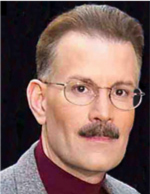Post-polio sequelae is a  misunderstood  condition by many medical professionals today.
 Dancing On Our Disabilities Radio interviews Dr. Richard Bruno

For more than thirty years, Dr. Richard L. Bruno has studied and treated nearly 6,000 polio survivors and is the world’s leading expert on Post-Polio Sequelae (PPS).
Click here to listen to Dr. Bruno’s interview
Post-Polio Sequelae is the name for the medically recognized condition caused by the late effects of the polio virus. Â Many people simply refer to it as PPS. Â Unfortunately, most able-bodied people do not understand the condition. Â The younger generation was not around when the polio epidemics swept through the world killing and paralyzing millions of people. Â The discovery of the Salk vaccine in 1955 ended the panic in western countries. Â It has taken much longer to eradicate it completely in other parts of the world. Â We are almost there.
Have you ever tried to explain what post-polio is to a young person?
It can be a frustrating experience for a polio survivor to manage Post-polio Sequelae. Â Some young doctors dismiss their issues because they do not see visible atrophy. Â Non- paralytic polio survivors, may not have been diagnosed at the time of the polio infection. Â Many believed they had a flu or stomach virus. Â Later in life some may also develop unexplained PPS symptoms. Â It can strike at any time whether you had paralytic polio or non-paralytic. Â Visible signs of muscle atrophy are not always present. Â Post-polio sequelae affects millions of polio survivors in mid-to-late life. Â As senior physicians retire, they are replaced by younger doctors. Â It is not an easy condition to recognize leaving most doctors to rely on eliminating the possibility of other disorders. Â Communication problems may occur between the PPS patient and the doctor. Â Medical schools in the western countries do not place much emphsis on Polio. Â Live polio cases are believed to be a thing of the past in western cultures. Â A resident recently told me that polio and post-polio information was literally nonexistent in her medical school textbooks. Â She told me that she had never seen anyone who had been affected by polio. Â I was her first experience.
Many physicians do not recognize post polio sequelae as a serious condition.  Sometimes patients are perceived as neurotic.  Inevitably, the patient feels helpless.  I can honestly say as a polio survivor with Post-polio it can be very dangerous if your treating physician does not know or understand the  ramifications of the condition.  Often the post-polio patient has to educate their doctor.  Many polio survivors develop related conditions, which stem from the initial infection.  Frequently, they have respiratory issues, difficulty swallowing, sensitivity to anesthesia, bone loss resulting in osteoporosis,  life-threatening fractures, muscle and joint pain, low body temperature, extreme fatigue, sleep issues, an ongoing deterioration of strength, and an acute problem with balance and spinal cord injuries.
Recently during a visit to my doctors office I had a scary incident.  She had a new nurse.  She insisted that I step up onto a scale.  It did not have handlebars.  I told her that I weighed 120.  It was unnecessary for me to take the chance of falling off.  She insisted claiming she would catch me.  Actually, she did have to catch me. Don’t push yourself  physically and never let anyone else request that you do something that you are not comfortable doing.  We understand our limitations and our capabilities.
Post-polio Sequelae helps to make us warriors
Polio survivors have a natural resilience.  The very nature of the condition makes us fighters and survivors.  When we experience a disappointment and our bodies fail us, we push a little harder.  However, it is a battle that people with post-polio cannot win in a conventional way.  Pushing harder works against us physically.  As able-bodied people age they begin to lose muscle mass.  Medical specialists promote exercise as a routine to keep them young and fit.  Unfortunately, this approach does not work for people with post-polio sequelae.  We MUST Reserve to Preserve.  That is our motto.  Think about it.  It makes perfect sense.  Remember the old Elton John song ( Honky Cat)?  The lyrics say, “you cannot drink whiskey from a bottle of wine?† This holds true for a nerve and muscle which have deteriorated or died.  You will not be able to raise them from their grave.  You will only create increased weakness in areas where you still have some strength left through overuse.  Today we are hoping for a polio free tomorrow.
No more active polio and no more post-polio.
If you do not know what post polio is, or you suspect that someone you care about is struggling with it,  listen to Dancing on our Disabilities Radio interview Dr. Richard Bruno.
About Dr. Richard Bruno
Richard L(ouis) Bruno is internationally known as the world’s foremost expert on Post-Polio Sequelae (PPS, also known as “post-polio syndrome”), the unexpected and often disabling symptoms — overwhelming fatigue, muscle weakness, muscle and joint pain, sleep disorders, heightened sensitivity to anesthesia, cold intolerance, and difficulty swallowing and breathing — that occur in 75% of paralytic and 40% of non-paralytic polio survivors about 35 years after the poliovirus attack. (1)
Bruno, a research and clinical psychophysiologist trained at the New York State Psychiatric Institute, began studying PPS and treating polio survivors in 1982, when he was a fellow in the Department of Rehabilitation Medicine, Columbia University College of Physicians and Surgeons. (2) In 1984, Bruno organized and is chairperson of the International Post-Polio Task Force, which promotes PPS research, education and treatment in 25 countries. (3)
Bruno left Columbia and, in 1989, created and directed the Post-Polio Rehabilitation and Research Service at Kessler Institute for Rehabilitation, the first center for the study and comprehensive treatment of PPS (4), and in 1998 created The Post-Polio Institute at Englewood Hospital and Medical Center (5), which was closed in 2010. Bruno is now director of the International Centre for Polio Education, the new home of the International Post-Polio Task Force.





Loved hearing Dr. Bruno!!! I just happened upon this. What radio station – what time – what day? I had Polio at age 7. PPS reared its ugly head in my mid-50’s. Now, at 83, really struggling to live alone. I have lots of help – big family, but I don’t want to live with anyone. These years were supposed to be my reward for having seven kids and my Mother living with us. I am finally alone, loving it, but hard to manage. Thank you for this radio program!
Hi Carole,
Thank you and I am glad you enjoyed the show. Dr. Bruno was my doctor 20 years ago in NJ. I am in FL now. My shows are internet based and I do a new one every week on various topics. Sign up for the show announcements. If a topic is of interest to you, you can click on the link. https://myragoldick.com
It’s funny that you mentioned “living alone”. Just today
I went to a presentation on senior living in Palm Beach Florida. I’m still lucky enough to have my husband with me. However, we don’t know what tomorrow will bring or who will go first.
Do keep in touch,
Myra
Dr. Bruno’s book has been invaluable to my husband who has PPS. He was incorrectly diagnosed with a heavy duty course of PT as his treatment. Finally, correct diagnosis and doctor. We shared copies of specificied chapters to each type of doctor that he is seen by. The chapter on sleep problems was extremely important. We carry anesthesia guidelines with us to share with medical professionals if needed.
Hi Sarah,
Thank you for listening. I always feel honored when DR. Bruno visits with me on air.
This is his third visit. I am hoping he will visit again in a few months. If you want to ask him
questions, I will ask for them in advance so he can be ready when you call in.
I hope you and your husband stay well.
Myra